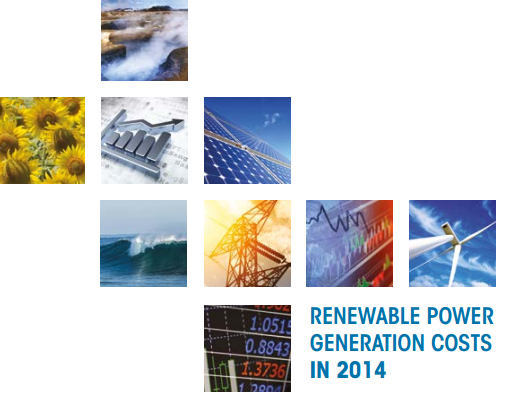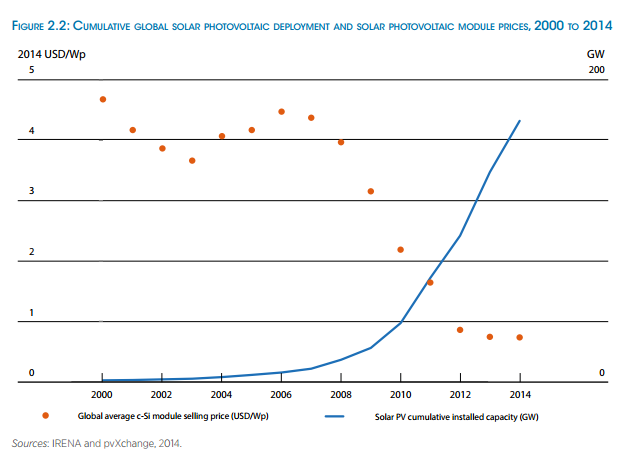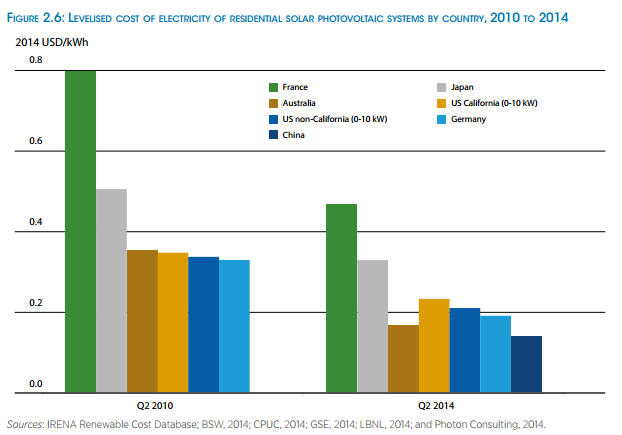
New reports from the International Renewable Energy Agency (IRENA) have shown the cost of renewable energy is falling below the cost of fossil fuels in many places around the world. Solar is leading the renewable energies with solar modules costs falling 75% since 2009.
IRENA’s report “Renewable Power Generation Costs in 2014” concludes that biomass, hydropower, geothermal and onshore wind are all competitive with or cheaper than coal, oil and gas-fired power stations – even without subsidies and taking into account the falling oil prices.
Individual wind projects are consistently generating electricity for US$0.05/kWhr without financial support, compared to US$0.045 to US$0.14/kWh for fossil-fuel power plants.
“Any remaining perceptions that renewable power generation technologies are expensive or uncompetitive are at best outdated, and at worst a dangerous fallacy,” Adnan Z. Amin, the director-general of IRENA.
“Renewable energy projects across the globe are now matching or outperforming fossil fuels, particularly when accounting for externalities like local pollution, environmental damage and ill health.”
“The game has changed; the plummeting price of renewables is creating a historic opportunity to build a clean, sustainable energy system and avert catastrophic climate change in an affordable way,” says Adnan.
The report states that solar PV costs have plummeted dramatically since 2009 – almost 75% – and will continue to decline further. The graph shows the sharp decline and in response, the sharp uptake of solar. The cost of electricity generated from utility scale solar systems has fallen 50% since 2010.

The graph below show how the cost of residential solar power system has also fallen between 2010 – 2014. The LCOE (levelized cost of electricity) in Australia has declined by 52%. Residential solar power systems are now as much at 70% cheaper than in 2008. Around the world, the cost of renewables of all types is falling to below grid prices.

“Now is the time for a step-change in deployment for renewables,” said Adnan Z. Amin. “It has never been cheaper to avoid dangerous climate change, create jobs, reduce fuel import bills and future-proof our energy system with renewables. This requires public acknowledgement of the low price of renewables, an end to subsidies for fossil fuels, and regulations and infrastructure to support the global energy transition.”
The report says there are no technical barriers to the increased integration of variable renewable resources.
” At low levels of penetration, the grid integration costs will be negative or modest, but can rise as penetration increases. Even so, when the local and global environmental costs of fossil fuels are taken into account, grid integration costs look considerably less daunting, even with variable renewable sources providing 40% of the power supply. In other words, with a level playing field and all externalities considered, renewables remain fundamentally competitive.”
Tags: biomass, cheaper than coal, climate change, cost of fossil fuels, Cost of Renewable Energy, geothermal, global environmental costs, hydropower, International Renewable Energy Agency, IRENA, onshore wind, renewable energy, Renewable Power Generation Costs in 2014, renewable sources, residential solar power system, solar PV costs, utility scale solar systems
